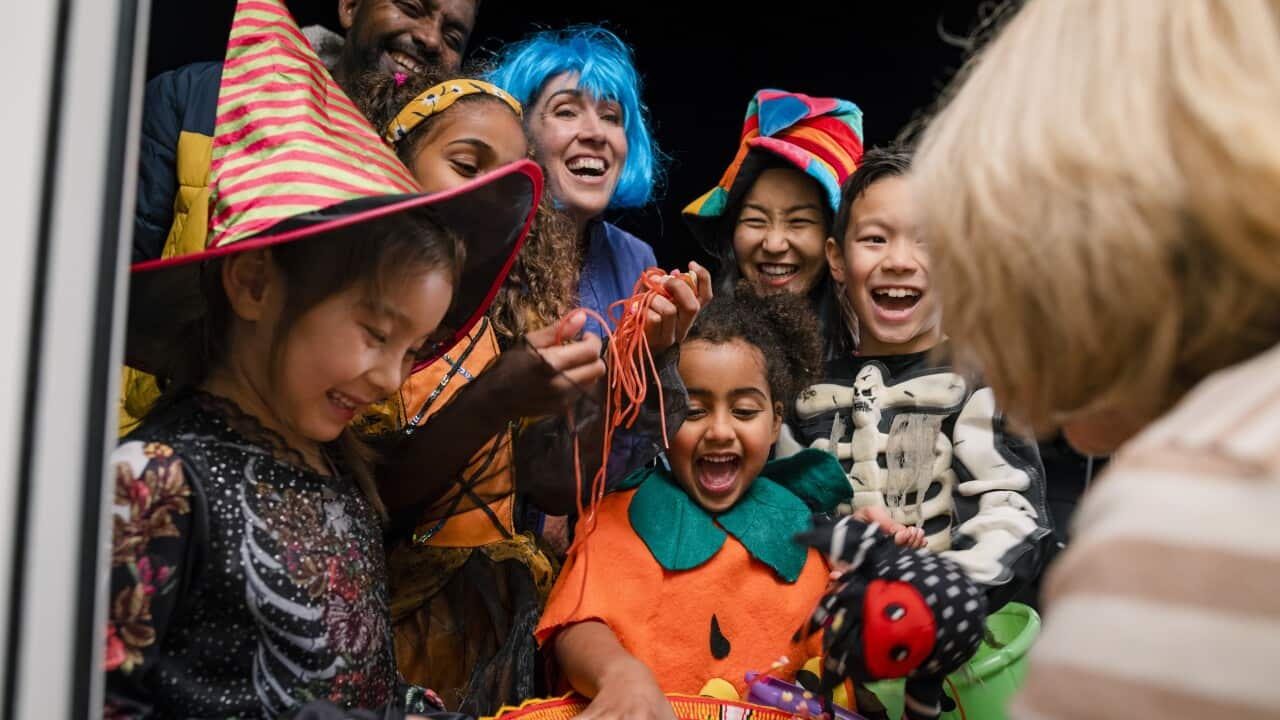Key Points
- While many think of Halloween as American, Irish immigrants introduced their traditions to America.
- Its roots come from the Gaelic festival of Samhain.
- Many Australians are marking Halloween by trick or treating, decorating their home or holding dress up parties.
With retailers anticipating Australians will spend $450 million on Halloween this year, there is no doubt there has been an increase in the number of Australians marking the spooky celebration.
This is despite the sentiment from some that "it's an American holiday, why do we celebrate it?" that most Australians have probably heard.
And while many of us may have learnt the basics about trick or treating from American movies or television shows, the idea that the celebration originated in the United States is actually a common misconception.
Halloween has its roots in Celtic Ireland.
Irish immigrants to America introduced some of the traditions that have evolved over time into what we think of as modern-day Halloween.
Why is Halloween celebrated on 31 October?
Across the world, Halloween is celebrated on the last night of October, so why did the Irish celebrate at that time of year?
Pamela O’Neill, the principal of the Australian School of Celtic Learning, said Halloween has come out of what was Samhain (pronounced sow-uhn), a seasonal festival from the early Celtic calendar.
"The year was split into four, Samhain in the northern hemisphere marks the beginning of winter or the onset of winter," she said.
Samhain translates as 'summer's end'.
"Celtic people believed that at this time, the division between the other world of spirits and the living world was thinner," O’Neill said.
Some people, especially those who follow pagan traditions, believe given seasons are different in the southern hemisphere to those in the northern hemisphere and that Australians are actually celebrating at the wrong time of year.

Pamela O'Neill Source: Supplied
Founder of Queensland Pagan Collective, Wayne Pina-Roozemond, said it would make more sense if Australians celebrated Halloween at the end of April.
"In the southern hemisphere, our Samhain is the first of May, so if we were to celebrate Halloween properly, it would be done then," he said.
But Pina-Roozemond said given the consumerism now involved in the celebration, he did not think retailers would be on board with this.
Scary fairies and other Celtic traditions
Celtics believed fairies or fae lived in the spirit world, which was most accessible to humans during Samhain because they were more likely to be moving about at the end of summer or the start of winter.
“We’re not talking about Tinkerbell; they're talking about otherworldly beings who are genuinely fairly unpleasant and often malicious,” O’Neill said.
According to the Irish foreign ministry, trick-or-treating (where children knock on people's doors and ask for treats, or they play a trick on them) dates back to when the poor would beg for food called ‘soul cakes’, when big bonfires were burnt to ward off evil spirits during Samhain, and that carved pumpkins known as jack-o-lanterns originated from carved turnips.
A video produced by the Ministry explained that people would hollow them out and carry embers from the bonfires home with them.
Memories of an Irish Halloween
Perth baker and mother of four Alicia Butler has fond memories of trick-or-treating .
She said the costumes were always very 'DIY', and 90 per cent of the 'treats' she'd come home with were a fruit, but it was always a fun time of year.
She lives within the City of Joondalup, where 1.6 per cent of the population was born in Ireland.
Butler started Alicia's Delights, a home-based baking business that specialises in Irish bread, such as soda bread and wheat bread.

Alicia Butler has passed her love of Halloween onto her Australian-born children. Source: Supplied
The dense bread is usually baked with a ring inside of it, and whoever gets the ring is considered to have good luck.
"You normally wrap it up in parchment paper, and then you bake it inside the bread, so you don't know whereabouts it is," she said.
While bread with a random ring baked inside may have been all the rage in the 1980s and 1990s, Butler said, unfortunately, today's health and safety standards meant she could not just go throwing a ring in to her barmbracks.
In keeping with the seasons
In Australia, those who still mark Samhain according to the seasons are generally those who follow the pagan calendar, known as the ‘wheel of the year.’
While pagans, modern-day witches and druids will not mark Samhain in the coming week as those in the northern hemisphere will, some will instead celebrate the seasonal festival known as Beltane.

The Beltane Fire Festival Source: AAP / David Cheskin
Pina-Roozemond, who organises the festival, said it attracts lots of Irish people, those from Nordic countries as well as people from Middle Eastern backgrounds.
Different cultures/similar reasons to celebrate
O’Neill said the Christian celebrations of All Saints' Day and All Hallows' Eve came to incorporate some of the ideas that originated from Samhain.
The Mexican celebration Dia De los Muertos (Day of the Dead), which celebrates the dead, is also said to have fed into what has become today’s Halloween celebration in different parts of the world.
"This is what happens in world religions and spiritualism, is that things get grafted onto each other; that’s the way it always happens," O’Neill said.
Some have also drawn parallels between Samhain, Halloween and the Indian festival of lights, Diwali, which is held according to the phases of the moon, during a similar part of the year.



